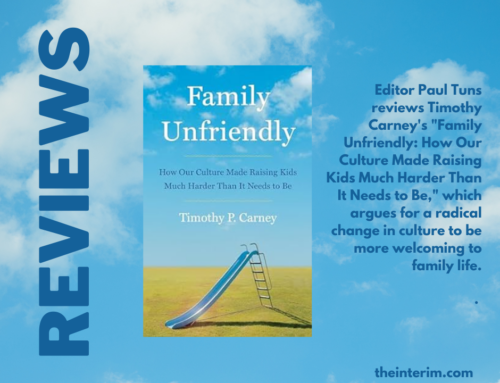On February 28, a month before the due date, my wife Christina was induced. Our family physician and the ob-gyn had determined that at 36 weeks, the child inside her was likely to be fully developed. There is a 96 per cent chance that the child’s lungs are fully developed at 36 weeks and a 98 per cent chance at 37. Waiting beyond 37 weeks was not a possibility considering the deteriorating health of my wife which she alluded to in last month’s column. She had pre-eclampsia which can lead to liver and kidney damage and the risk was determined to be too great. Every day mattered and the relative risk to the chil of waiting another week weighed against the risk to Christina made an early induction at 36 weeks the smart decision.
Shortly after midnight on March 2, Madelyn Rose Tuns was born. It was an easy delivery as deliveries go or at least that is what my wife and the nurses said. All seemed fine. Hospitals now send newborns and mother home so quickly although we were glad to have Madelyn and mom home on Thursday March 3, about 34 hours after the little one’s entry into the world. That day was celebratory and all seemed fine until after supper when Madelyn’s mouth and lips turned blue while she was asleep in my mother’s arms. Shaking the baby, Christina got her to breath again and for the next few hours everyone watched Madelyn a little closer. We all knew that baby’s occasionally “forget” to breath.
Later that night while watching television, the baby, laying on the bed beside Christina, once again changed colour, her face below her nose turning purplish-blue. In a panick Christina shook her awake but this time we would not take it so lightly. We returned to the emergency room of the hospital we had left just 12 hours earlier.
The pediatrician who examined Madelyn found nothing wrong and we overheard her saying that considering this was our fourth child, the concern should be taken seriously. But there was no room for a newborn at the hospital’s neonatal intensive care unit. Calls to other Toronto hospitals went nowhere and we were sent to Markham-Stoufville about 45 minutes from our home where Madelyn would go for a routine day of monitoring.
Thank God for the electronic monitoring which caught numerous small and several more serious apneic episodes in which Madelyn completely stopped breathing. Sometimes she pulled herself out of it, sometimes she needed to be stimulated by a nurse. It was clear that the episodes were not random and inconsequential events but something more serious. Her hospital stay would be longer than expected.
After several days, Madelyn was moved to the Hospital for Sick Children where they repeated the same blood work, examinations and x-rays that the staff at Markham-Stoufville had done, and then some.
We were extremely blessed to have both my mother and mother-in-law at our home to help with our three oldest children. I worked only part-time and Christina was at the hospital practically full-time. I am very fortunate that the staff at The Interim and Campaign Life Coalition (for whom I write the newsletter) were understanding and let me come in and out as I needed.
Despite dropping by the office to ensure the paper was on track (we pushed the publication date back a week), it was difficult to follow the news, including the goings-on of the Liberal and Conservative conventions, the developing Terri Schindler-Schiavo story and all the other world events of which an editor must stay on top. More importantly, I lost track of what was happening in Spring training. Were my beloved New York Yankees performing at the level necessary to beat the dreaded Boston Red Sox? At the time, it didn’t matter.
March was a difficult month, to say the least. At the same time it was a blessing. I know agnostics and some who long ago left their churches who passed on messages that they were praying for Madelyn and our family. Christina and I talked about this and when times were dark and we honestly did not know if Madelyn would ever be coming back home, we understood that God has a plan and that perhaps Madelyn’s “purpose” was to draw people closer to Him.
The travails were also a useful reminder to us to pray as a family and to do so frequently. I had conversations with numerous people who said that we can find comfort and strength in prayers when, in their words, “there is nothing else we can do.” This got me to thinking: such sentiments were dead wrong in the implication that we pray as a last resort. In fact, we should always pray first.
Two wise women who knew this were Interim columnist Grace Petrasek and CLC’s Rhonda Wood. Grace, who knows that we are Catholic, sent a booklet on St. Gerard, patron Saint of expectant mothers, after reading last month’s column by Christina discussing some of her difficulties. Our family often prayed to St. Gerard during Christina’s pregnancy, but the booklet enriched my understanding of why this was so important.
Rhonda sent an incredibly helpful and comforting email during Madelyn’s first day in the hospital which reminded us to pray to Mary who had helplessly watched her own child suffer. Rhonda reminded Christina and myself to find strength in Our Lady’s example and indeed it provided much needed courage.
But neither our prayers to St. Gerard or Mary were prayers of last resort or even prayers of desperation. They were a recognition that everything is in God’s hands. We must have the humility to accept that God is in charge, that for all things there is a purpose and that we are never challenged by anything more difficult than we can face as long as we face it with Him.
On March 24, we brought Madelyn home a second time, in time to celebrate Easter. The physician’s official diagnosis (read: best guess) was that Madelyn was not fully developed because she was four weeks premature. As of this writing, days after that joyous return home, Madelyn has gone more than two weeks without a apneic episode and although we appear to be out of the woods, our family continues to pray for the strength, courage and wisdom that we will need in the weeks, indeed years, to co




